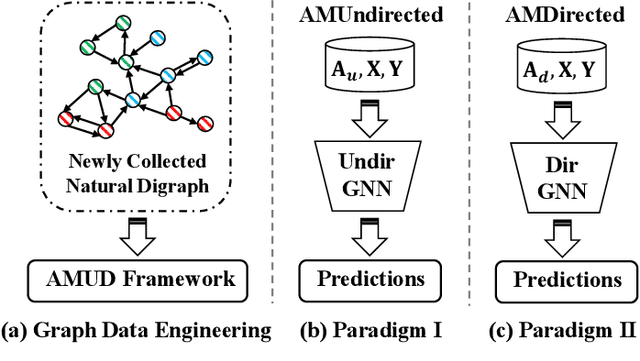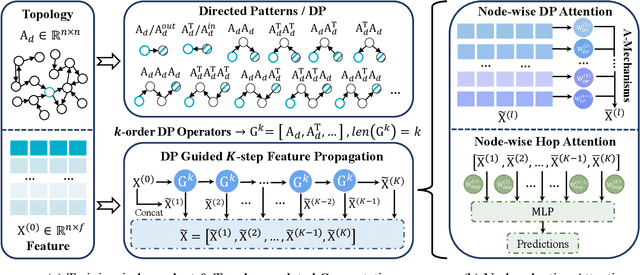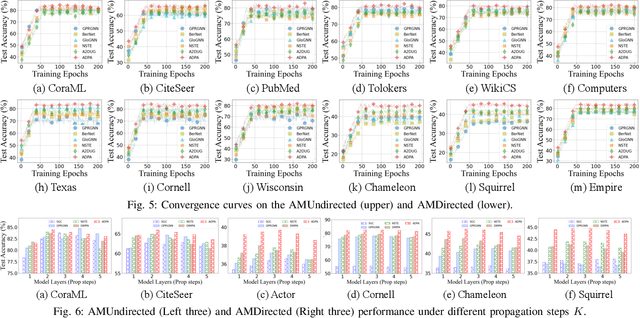Henan Sun
Rethinking Graph Out-Of-Distribution Generalization: A Learnable Random Walk Perspective
May 09, 2025Abstract:Out-Of-Distribution (OOD) generalization has gained increasing attentions for machine learning on graphs, as graph neural networks (GNNs) often exhibit performance degradation under distribution shifts. Existing graph OOD methods tend to follow the basic ideas of invariant risk minimization and structural causal models, interpreting the invariant knowledge across datasets under various distribution shifts as graph topology or graph spectrum. However, these interpretations may be inconsistent with real-world scenarios, as neither invariant topology nor spectrum is assured. In this paper, we advocate the learnable random walk (LRW) perspective as the instantiation of invariant knowledge, and propose LRW-OOD to realize graph OOD generalization learning. Instead of employing fixed probability transition matrix (i.e., degree-normalized adjacency matrix), we parameterize the transition matrix with an LRW-sampler and a path encoder. Furthermore, we propose the kernel density estimation (KDE)-based mutual information (MI) loss to generate random walk sequences that adhere to OOD principles. Extensive experiment demonstrates that our model can effectively enhance graph OOD generalization under various types of distribution shifts and yield a significant accuracy improvement of 3.87% over state-of-the-art graph OOD generalization baselines.
Towards Data-centric Machine Learning on Directed Graphs: a Survey
Nov 28, 2024



Abstract:In recent years, Graph Neural Networks (GNNs) have made significant advances in processing structured data. However, most of them primarily adopted a model-centric approach, which simplifies graphs by converting it into undirected formats and emphasizes model designs. This approach is inherently constrained in real-world applications due to inevitable information loss in simple undirected graphs and data-driven model optimization dilemmas associated with exceeding the upper bounds of representational capacity. As a result, there has been a shift toward data-centric methods that prioritize improving graph quality and representation. Specifically, various types of graphs can be derived from naturally structured data, including heterogeneous graphs, hypergraphs, and directed graphs. Among these, directed graphs offer distinct advantages in topological systems by modeling causal relationships, and directed GNNs have been extensively studied in recent years. However, a comprehensive survey of this emerging topic is still lacking. Therefore, we aim to provide a comprehensive review of directed graph learning, with a particular focus on a data-centric perspective. Specifically, we first introduce a novel taxonomy for existing studies. Subsequently, we re-examine these methods from the data-centric perspective, with an emphasis on understanding and improving data representation. It demonstrates that a deep understanding of directed graphs and its quality plays a crucial role in model performance. Additionally, we explore the diverse applications of directed GNNs across 10+ domains, highlighting their broad applicability. Finally, we identify key opportunities and challenges within the field, offering insights that can guide future research and development in directed graph learning.
AdaFGL: A New Paradigm for Federated Node Classification with Topology Heterogeneity
Jan 22, 2024Abstract:Recently, Federated Graph Learning (FGL) has attracted significant attention as a distributed framework based on graph neural networks, primarily due to its capability to break data silos. Existing FGL studies employ community split on the homophilous global graph by default to simulate federated semi-supervised node classification settings. Such a strategy assumes the consistency of topology between the multi-client subgraphs and the global graph, where connected nodes are highly likely to possess similar feature distributions and the same label. However, in real-world implementations, the varying perspectives of local data engineering result in various subgraph topologies, posing unique heterogeneity challenges in FGL. Unlike the well-known label Non-independent identical distribution (Non-iid) problems in federated learning, FGL heterogeneity essentially reveals the topological divergence among multiple clients, namely homophily or heterophily. To simulate and handle this unique challenge, we introduce the concept of structure Non-iid split and then present a new paradigm called \underline{Ada}ptive \underline{F}ederated \underline{G}raph \underline{L}earning (AdaFGL), a decoupled two-step personalized approach. To begin with, AdaFGL employs standard multi-client federated collaborative training to acquire the federated knowledge extractor by aggregating uploaded models in the final round at the server. Then, each client conducts personalized training based on the local subgraph and the federated knowledge extractor. Extensive experiments on the 12 graph benchmark datasets validate the superior performance of AdaFGL over state-of-the-art baselines. Specifically, in terms of test accuracy, our proposed AdaFGL outperforms baselines by significant margins of 3.24\% and 5.57\% on community split and structure Non-iid split, respectively.
Breaking the Entanglement of Homophily and Heterophily in Semi-supervised Node Classification
Dec 07, 2023



Abstract:Recently, graph neural networks (GNNs) have shown prominent performance in semi-supervised node classification by leveraging knowledge from the graph database. However, most existing GNNs follow the homophily assumption, where connected nodes are more likely to exhibit similar feature distributions and the same labels, and such an assumption has proven to be vulnerable in a growing number of practical applications. As a supplement, heterophily reflects dissimilarity in connected nodes, which has gained significant attention in graph learning. To this end, data engineers aim to develop a powerful GNN model that can ensure performance under both homophily and heterophily. Despite numerous attempts, most existing GNNs struggle to achieve optimal node representations due to the constraints of undirected graphs. The neglect of directed edges results in sub-optimal graph representations, thereby hindering the capacity of GNNs. To address this issue, we introduce AMUD, which quantifies the relationship between node profiles and topology from a statistical perspective, offering valuable insights for \underline{A}daptively \underline{M}odeling the natural directed graphs as the \underline{U}ndirected or \underline{D}irected graph to maximize the benefits from subsequent graph learning. Furthermore, we propose \underline{A}daptive \underline{D}irected \underline{P}attern \underline{A}ggregation (ADPA) as a new directed graph learning paradigm for AMUD. Empirical studies have demonstrated that AMUD guides efficient graph learning. Meanwhile, extensive experiments on 14 benchmark datasets substantiate the impressive performance of ADPA, outperforming baselines by significant margins of 3.96\%.
 Add to Chrome
Add to Chrome Add to Firefox
Add to Firefox Add to Edge
Add to Edge